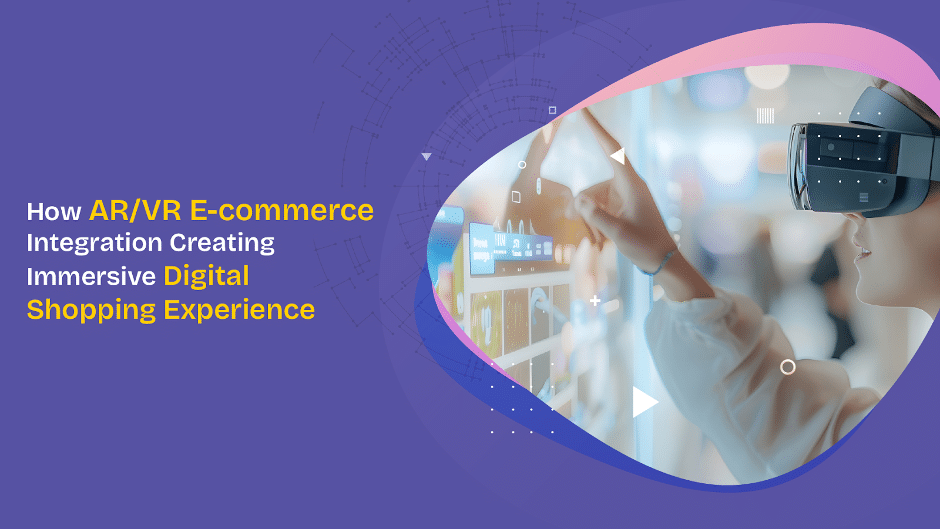
E-commerce has come a long way since its inception, yet it still has a long way to go before it can fully replicate the in-store experience. Two emerging technologies that are assisting in bridging the gap between digital and physical interactions are augmented reality and virtual reality. Together, AR and VR enhance the customer experience and enable immersive digital shopping experiences.
With the advent of new web-enabled augmented reality technology, businesses are focusing on customized shopping experiences, utilizing data analysis to offer customized product suggestions. AR-enabled solutions have the potential to increase the accessibility of ecommerce for people with impairments.
The Immersive Shopping Experience
These advanced technologies have become powerful tools, altering online product interactions. Ecommerce companies use AR/VR to immerse customers and make online shopping more interactive. These innovative technologies are revolutionizing product personalization and engagement.
Role of AR in Providing Immersive Shopping Experiences
Augmented reality in ecommerce has transformed purchasing by blending digital and real-world content. AR technology lets people virtually experience digital life at their homes, enabling informed purchases. Furniture retailers employ augmented reality to enable consumers to really arrange furniture in their living rooms for a great fit and beauty.
Role of VR in Providing Immersive Shopping Experiences
Virtual reality strategies for online retail engage customers in fully immersive digital settings, creating a more engaging shopping experience. VR lets customers tour virtual showrooms, attend product launches, and interact with objects as in real life. Fashion firms use VR to build virtual fitting rooms so customers can try on clothes and accessories without visiting a shop.
Optimizing Online Experiences
The widespread use, adoption of augmented reality (AR) and virtual reality (VR) has revolutionized the way consumers interact with products and services online. These immersive experiences not only enhance the shopping journey but also offer practical solutions to common pain points. By leveraging AR and VR, businesses can minimize product returns, boost conversion rates, and simplify interior design processes. Let’s explore how these cutting-edge technologies are optimizing online experiences, leading to increased customer satisfaction and revenue growth.
1) Reduce Product Returns with Accurate Representations
The integration of AR/VR technology in digital commerce provides a significant benefit when implemented in e-commerce. By creating more immersive and engaging purchasing environments, these technologies effectively mitigate product returns resulting from misaligned expectations or inaccurate product representations.
Consumers can thoroughly assess product suitability, dimensions, hue and alignment through the use of virtual try-on capabilities and simulations. Accuracy and transparency decrease return risk, thereby conserving money and enhancing productivity for businesses. By integrating AR/VR into retail websites and other immersion strategies, e-commerce immersion strategies enable this enhanced purchasing experience.
2) Impact of AR/VR on Conversion Rates and Sales
Enhancing e-commerce with AR and VR technologies reduces returns and increases conversion rates and revenue. Businesses can potentially increase conversion rates by enabling users to navigate interactive online shopping environments virtually or view products in their own settings. Customers are more inclined to make a purchase when they can visually perceive a product’s appearance and functionality.
3) Virtual Interior Design & Decoration using AR
Augmented reality has changed how clients decorate and create their homes. AR technology lets clients virtually put furniture and décor in their existing spaces to see how they will appear and fit into their design preferences.
4) Helping Customers Visualize Furniture and Decor in Their Homes
AR allows buyers to try out alternative furniture configurations, color schemes, and design aspects without buying or relocating them. Visualization and customization improve shopping and lessen the possibility of expensive errors or discontent.
Conclusion
The integration of VR and AR technology into e-commerce is capable of changing the overall online shopping experience. Immersive technologies improve customer engagement, product returns, conversions, and revenues. Augmented reality (AR), virtual reality (VR), and personalized purchasing environments are significantly transforming the digital consumer experience by offering lifelike product representations and virtual try-on capabilities. Enterprise adoption of these cutting-edge technologies might revolutionize immersive digital retail experiences, eliminating the line between the physical and digital worlds.
However, these technologies truly shine when built upon a foundation of core digital Ecommerce capabilities. This is where the expertise and support of a reliable technology partner like Mayura Consultancy Services become crucial, enabling the effective use of virtual reality and augmented reality to enhance customer experience and create immersive digital shopping experiences.
FAQs
1) What role do AR and VR play in immersive shopping?
Augmented reality has transformed purchasing by blending digital and real-world content. AR technology lets people virtually experience things in their homes, enabling informed purchases. Online virtual reality techniques engage customers in fully immersive digital settings, creating a more engaging shopping experience.
2) How do AR and VR contribute to reducing product returns?
AR and VR’s lifelike presentation is a major advantage of employing them in e-commerce. These technologies make online and physical shopping more immersive and engaging, reducing product returns due to mismatched expectations or poor product portrayal.
3) What is the impact of AR/VR on conversion rates and sales?
Besides lowering returns, AR and VR technologies boost e-commerce conversion rates and revenues. Immersive and engaging shopping experiences enhance the consumer journey by generating enthusiasm and emotional connection to items.
4) How does AR benefit virtual home decoration and interior design?
Augmented reality has changed how clients decorate and create their homes. AR technology lets clients virtually put furniture and décor in their existing spaces to see how they will appear and fit into their design preferences.
5) How does AR enable customers to visualize furniture and decor items in their living spaces?
AR lets buyers try out alternative furniture configurations, color schemes and design aspects without buying or relocating them. Visualization and customization improve shopping and lessen the possibility of expensive errors or discontent.